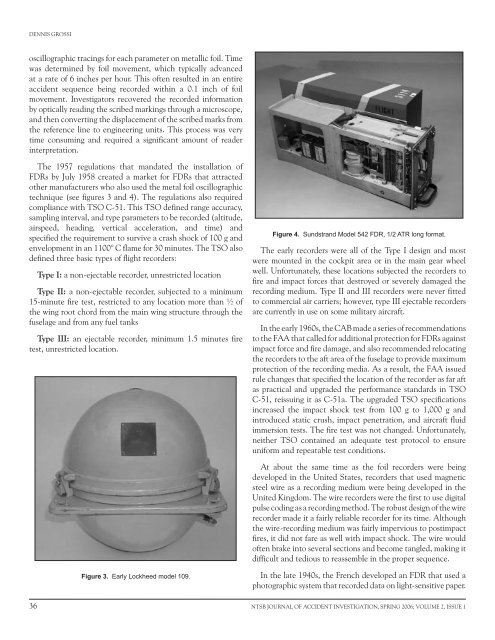Journal of Accident Investigation
Journal of Accident Investigation
Journal of Accident Investigation
Create successful ePaper yourself
Turn your PDF publications into a flip-book with our unique Google optimized e-Paper software.
DENNIS GROSSI<br />
oscillographic tracings for each parameter on metallic foil. Time<br />
was determined by foil movement, which typically advanced<br />
at a rate <strong>of</strong> 6 inches per hour. This <strong>of</strong>ten resulted in an entire<br />
accident sequence being recorded within a 0.1 inch <strong>of</strong> foil<br />
movement. Investigators recovered the recorded information<br />
by optically reading the scribed markings through a microscope,<br />
and then converting the displacement <strong>of</strong> the scribed marks from<br />
the reference line to engineering units. This process was very<br />
time consuming and required a significant amount <strong>of</strong> reader<br />
interpretation.<br />
The 19 7 regulations that mandated the installation <strong>of</strong><br />
FDRs by July 19 8 created a market for FDRs that attracted<br />
other manufacturers who also used the metal foil oscillographic<br />
technique (see figures 3 and 4). The regulations also required<br />
compliance with TSO C- 1. This TSO defined range accuracy,<br />
sampling interval, and type parameters to be recorded (altitude,<br />
airspeed, heading, vertical acceleration, and time) and<br />
specified the requirement to survive a crash shock <strong>of</strong> 100 g and<br />
envelopment in an 1100° C flame for 30 minutes. The TSO also<br />
defined three basic types <strong>of</strong> flight recorders:<br />
Type I: a non-ejectable recorder, unrestricted location<br />
Type II: a non-ejectable recorder, subjected to a minimum<br />
1 -minute fire test, restricted to any location more than ½ <strong>of</strong><br />
the wing root chord from the main wing structure through the<br />
fuselage and from any fuel tanks<br />
Type III: an ejectable recorder, minimum 1. minutes fire<br />
test, unrestricted location.<br />
Figure 3. Early Lockheed model 109.<br />
Figure 4. Sundstrand Model 542 FDR, 1/2 ATR long format.<br />
The early recorders were all <strong>of</strong> the Type I design and most<br />
were mounted in the cockpit area or in the main gear wheel<br />
well. Unfortunately, these locations subjected the recorders to<br />
fire and impact forces that destroyed or severely damaged the<br />
recording medium. Type II and III recorders were never fitted<br />
to commercial air carriers; however, type III ejectable recorders<br />
are currently in use on some military aircraft.<br />
In the early 1960s, the CAB made a series <strong>of</strong> recommendations<br />
to the FAA that called for additional protection for FDRs against<br />
impact force and fire damage, and also recommended relocating<br />
the recorders to the aft area <strong>of</strong> the fuselage to provide maximum<br />
protection <strong>of</strong> the recording media. As a result, the FAA issued<br />
rule changes that specified the location <strong>of</strong> the recorder as far aft<br />
as practical and upgraded the performance standards in TSO<br />
C- 1, reissuing it as C- 1a. The upgraded TSO specifications<br />
increased the impact shock test from 100 g to 1,000 g and<br />
introduced static crush, impact penetration, and aircraft fluid<br />
immersion tests. The fire test was not changed. Unfortunately,<br />
neither TSO contained an adequate test protocol to ensure<br />
uniform and repeatable test conditions.<br />
At about the same time as the foil recorders were being<br />
developed in the United States, recorders that used magnetic<br />
steel wire as a recording medium were being developed in the<br />
United Kingdom. The wire recorders were the first to use digital<br />
pulse coding as a recording method. The robust design <strong>of</strong> the wire<br />
recorder made it a fairly reliable recorder for its time. Although<br />
the wire-recording medium was fairly impervious to postimpact<br />
fires, it did not fare as well with impact shock. The wire would<br />
<strong>of</strong>ten brake into several sections and become tangled, making it<br />
difficult and tedious to reassemble in the proper sequence.<br />
In the late 1940s, the French developed an FDR that used a<br />
photographic system that recorded data on light-sensitive paper.<br />
36 NTSB JOURNAL OF ACCIDENT INVESTIGATION, SPRING 2006; VOLUME 2, ISSUE 1
















